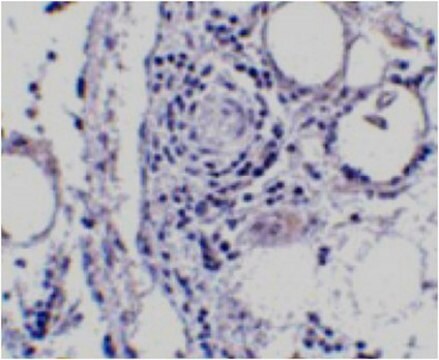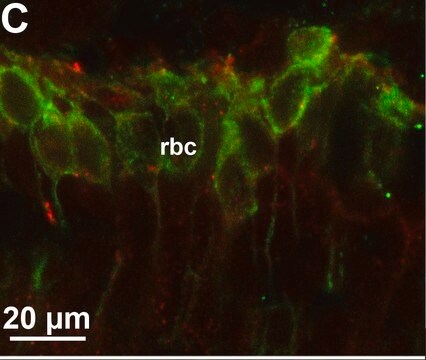ABN14
抗脑脂质结合蛋白抗体
from rabbit, purified by affinity chromatography
别名:
Brain lipid-binding protein, Fatty acid-binding protein 7, Mammary-derived growth inhibitor related, brain lipid binding protein, fatty acid binding protein 7, brain, mammary-derived growth inhibitor-related
登录查看公司和协议定价
所有图片(4)
About This Item
分類程式碼代碼:
12352203
eCl@ss:
32160702
NACRES:
NA.41
推荐产品
生物源
rabbit
品質等級
抗體表格
affinity isolated antibody
抗體產品種類
primary antibodies
無性繁殖
polyclonal
純化經由
affinity chromatography
物種活性
mouse
物種活性(以同源性預測)
human (based on 100% sequence homology)
包裝
antibody small pack of 25 μg
技術
immunohistochemistry: suitable
western blot: suitable
NCBI登錄號
UniProt登錄號
運輸包裝
ambient
目標翻譯後修改
unmodified
基因資訊
human ... FABP7(2173)
mouse ... Fabp7(12140)
一般說明
BLBP(脑脂质结合蛋白)属于一个高度保守的胞质小分子蛋白家族,可结合长链脂肪酸和其他疏水性配体。BLBP在脂肪酸摄取、转运和代谢中起着重要作用。BLBP可用作发育中的中枢神经系统中的放射状胶质细胞(主要的神经祖细胞类型和支持神经元迁移的支架)的分子标记。放射状神经胶质细胞通过其作为神经元前体和作为神经元迁移向导的功能,在大脑皮层的形成过程中发挥着重要作用。
特異性
大鼠同源性-88%。
该抗体可识别脑脂质结合蛋白。
免疫原
具有GST标签的重组蛋白,与人脑脂质结合蛋白相对应。
表位:细胞质结构域
應用
使用此抗脑脂质结合蛋白抗体检测脑脂质结合蛋白,该抗体经过验证可用于WB、IH。
免疫组化分析: 一个先前批次ABN14抗体以1:300的稀释度在小鼠小脑组织中检测到脑脂质结合蛋白。
研究子类别
神经 & 胶质标记
神经 & 胶质标记
研究类别
神经科学
神经科学
品質
已通过蛋白质印迹在P1小鼠脑组织裂解物中进行了评估。
蛋白质印迹分析:0.01 µg/ml该抗体在10 µg P1小鼠脑组织裂解液中检测到脑脂质结合蛋白。
蛋白质印迹分析:0.01 µg/ml该抗体在10 µg P1小鼠脑组织裂解液中检测到脑脂质结合蛋白。
標靶描述
~ 15 kDa
聯結
替代品:AB9558
外觀
亲和纯化
纯化的兔单克隆抗体,溶于含有0.1 M Tris-甘氨酸(pH 7.4)、150 mM NaCl和0.05%叠氮化钠的缓冲液中。
儲存和穩定性
自发运之日起,在 2-8°C 条件下可稳定保存1年
分析報告
对照
P1小鼠脑组织裂解液
P1小鼠脑组织裂解液
其他說明
浓度:请参考批次特异性浓缩物的分析证书。
免責聲明
除非我们的产品目录或产品附带的其他公司文档另有说明,否则我们的产品仅供研究使用,不得用于任何其他目的,包括但不限于未经授权的商业用途、体外诊断用途、离体或体内治疗用途或任何类型的消费或应用于人类或动物。
Not finding the right product?
Try our 产品选型工具.
儲存類別代碼
12 - Non Combustible Liquids
水污染物質分類(WGK)
WGK 1
閃點(°F)
Not applicable
閃點(°C)
Not applicable
A mouse model of human primitive neuroectodermal tumors resulting from microenvironmentally-driven malignant transformation of orthotopically transplanted radial glial cells.
Malchenko, S; Sredni, ST; Hashimoto, H; Kasai, A; Nagayasu, K; Xie, J; Margaryan et al.
Testing null
Vivek K Bajpai et al.
Stem cells (Dayton, Ohio), 35(5), 1402-1415 (2017-02-01)
During development, neural crest (NC) cells are induced by signaling events at the neural plate border of all vertebrate embryos. Initially arising within the central nervous system, NC cells subsequently undergo an epithelial to mesenchymal transition to migrate into the
Constance A Rich et al.
Glia, 66(12), 2617-2631 (2018-09-27)
We and others previously showed that in mouse embryos lacking the transcription factor Sox10, olfactory ensheathing cell (OEC) differentiation is disrupted, resulting in defective olfactory axon targeting and fewer gonadotropin-releasing hormone (GnRH) neurons entering the embryonic forebrain. The underlying mechanisms
Chrysoula Konstantinidou et al.
BMC biology, 14(1), 94-94 (2016-10-26)
In vertebrate organisms, the neural crest (NC) gives rise to multipotential and highly migratory progenitors which are distributed throughout the embryo and generate, among other structures, the peripheral nervous system, including the intrinsic neuroglial networks of the gut, i.e. the
Mayumi Okamoto et al.
Nature communications, 7, 11349-11349 (2016-04-21)
During cerebral development, many types of neurons are sequentially generated by self-renewing progenitor cells called apical progenitors (APs). Temporal changes in AP identity are thought to be responsible for neuronal diversity; however, the mechanisms underlying such changes remain largely unknown.
我们的科学家团队拥有各种研究领域经验,包括生命科学、材料科学、化学合成、色谱、分析及许多其他领域.
联系技术服务部门







